"People leave managers not companies" is a common refrain you'll hear when corporate leadership is discussed.
But is it really true? And if it is, why do people leave their managers?

Missing the forest for the trees.
When you hear why your friend took their new job, you often hear these kinds of rationalizations:
- "The pay is great": They got a raise or a better commission structure.
- "The job is really exciting": They're excited for the new role and challenges.
- "I really liked the people I'd be working with": They were drawn to the people they interviewed with.
All of these reasons make perfect sense. Unless a past job was *really* bad, most people don't want to be negative, and speak poorly about their past employer. They like to be optimistic that they're going to a new job, not away from their last job.

While all that is true, you can't get a new job unless you decide to take an interview. This means the root cause of someone leaving a company is the moment they decide to submit their resume, or finally interview at their friend's company.
The real reasons for turnover usually point squarely back at their manager. This is due to the manager's actions, or often, inaction, on what drives engagement and long term retention. Today, we look at this evidence for why people leave managers, not companies.
Table of Contents:
1) The Evidence
This section explores the underlying reasons why employees are more likely to quit their jobs due to poor management rather than other factors related to the company itself.
- Why People Leave Managers, not Companies
- The Hidden Impact of Managers
- Leaving a Job Because of Current Management By the Numbers
2) What to do about it
We will describe the main reasons why employees leave managers, not companies and provide you recommendations that will help you to avoid these situations.
- Communication, communication, communication
- Your people want to grow, grow, grow, grow, grow
- Managers represent your company's leadership
- Never enough feedback and praise
- People quit bosses due to an over-reliance on perks (but they don't work)
- Conclusion: Employees leave managers not companies, so it's on You to turn that around
Why People Leave Managers, not Companies.
In Gallup's comprehensive study, "The State of the American Manager," they found a harsh truth:
- 50% of Americans have left a job to "get away from their manager at some point in their career."
So half of all Americans have had the #1 reason for leaving a job be their boss.
But given the career trends in America, most people have had multiple jobs. What about all those other jobs they've had along the way?
And what about the half that haven't felt the need to ever, "get away from their manager"?
The Hidden Impact of Managers
Your manager impacts so much of your work experience. They help determine what projects you work on, who you work with, and when/if you get promoted. They're also the person most likely to be able to help you when you have a problem.
As Andy Grove, the former co-founder and CEO of Intel, wrote in his management classic, High Output Management, managers have significant control over their team's performance:
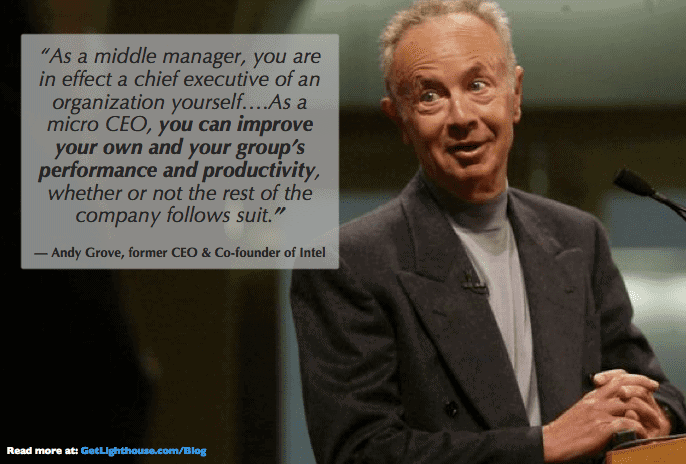
While he was focused on the positive aspects, the downside is equally true: a manager can damage the morale, motivation, and productivity of their teams based on their actions, or inaction.
Leaving a Job Because of Current Management By the Numbers
In Gallup's study of managers, they found that, "The manager accounts for at least 70% of the variance in employee engagement."
If you like your job, and are engaged, there's a much lower chance you'll go interview somewhere else.
Gallup's own findings showed the turnover difference for engaged vs. disengaged teams was dramatic:
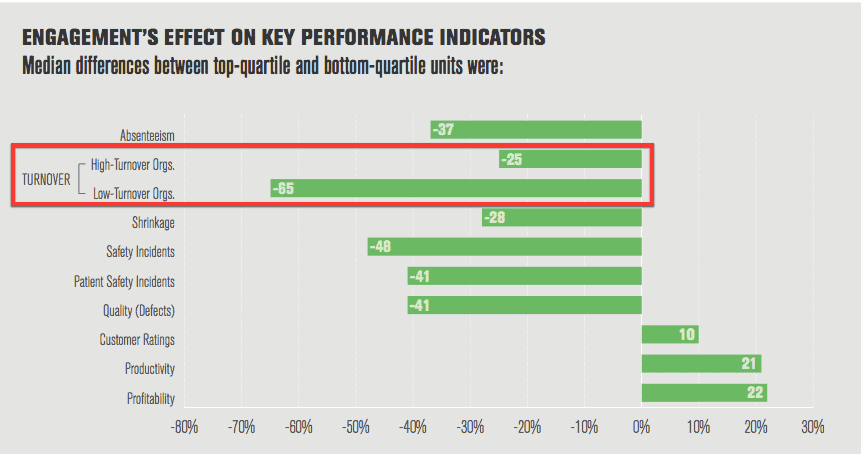
And unfortunately, we also know that in recent years the majority of employees have not been engaged:
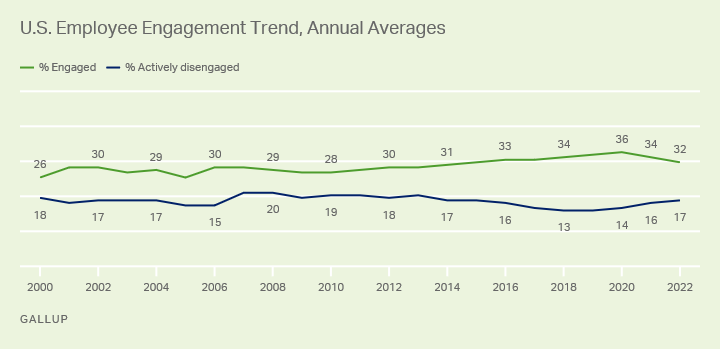
This means that most managers are not doing the things that drive engagement. These are your hidden factors why people leave managers, not companies.
Let's take a look at what these reasons are that people quit bosses they don't like working for, and how you can avoid being one of them.
1) Communication, communication, communication
Without open lines of communication, managers are setting themselves up to be blindsided by a valued team member leaving.
A team member's departure should never be a surprise. There are always warning signs, and opportunities to have fixed things along the way.
Unfortunately, those problems are easy to ignore, especially if your team is uncomfortable coming to you with them. It turns out that Gallup found that your team's comfort in coming to you, is one of the major keys to engagement:

If a team member doesn't feel comfortable coming to their manager, you can see that there's almost no chance they're engaged.
That's not surprising, is it? If you were afraid to approach your boss, how would that make you feel about work?
Most managers are afraid
A study of managers by Interact Studio and Harris Poll revealed that the fear goes both ways; 69% of managers are just as afraid of communication as their teams:
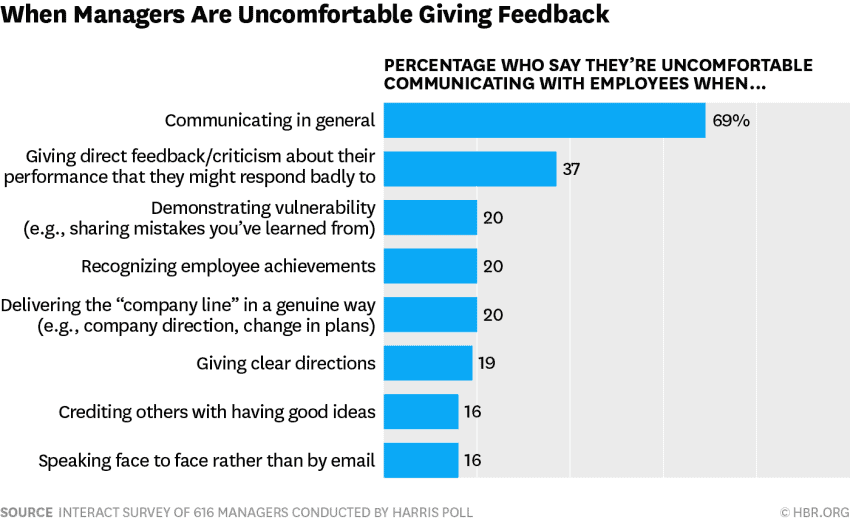
If both sides are afraid to have tough conversations, they're never going to happen. Managers must have the courage and confidence to communicate with their team.
What to do about it: Everyone needs One on Ones.
How do you build strong lines of communication? By making it a priority.
The best way to prioritize communication is to regularly schedule time for it. For the uninitiated, this is what a one on one is for. It's why Andy Grove said:

If you don't have one on ones currently, you should start. Schedule 30-60 minutes every 1-2 weeks to meet with each person on your team individually.
Make the most of your one on ones
This post can walk you step-by-step through the process of starting them. They can be awkward at first, but as you get used to them, communication will get better and easier.
If you're already having one on ones either sporadically, or they don't feel valuable, work on improving them. These suggested questions for individual contributors, and these for one on ones with managers, can help you focus on the right things.
Those questions will also show you how many different topics you can discuss. This is why you need to have them regularly, and should "never" waste them on status updates.
When you make the most of your one on ones, you create a safe place to regularly have necessary and productive discussions. All the topics that normally don't have time to be discussed now have a comfortable place to do so.
This helps avoid any surprises, and gives you and your team members a place to talk about how to fix problems when their small. This allows issues that could boil over and lead to major problems (and departure) to never reach that point. [Ed note: Free 1:1 Meeting Template + Helpful Guide for Managers.]

2) Your people want to grow, grow, grow, grow, grow
We look at a lot of the latest workplace research here at Lighthouse, and it's stunning how much evidence there is now showing how badly employees want growth opportunities.
In Mary Meeker's Internet Trends report, it showed that growth through training and development was the top benefit people wanted:
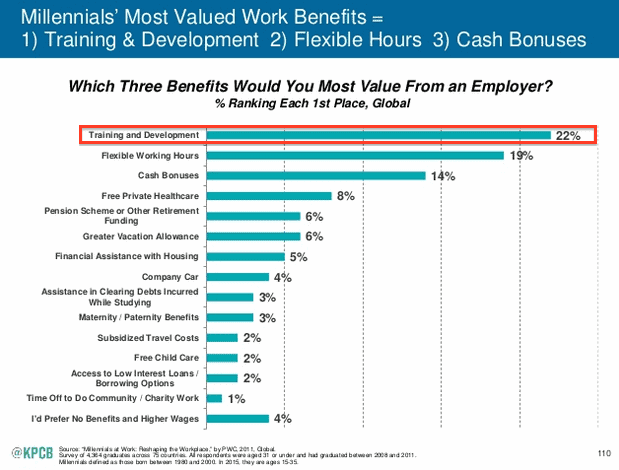
Then, Deloitte's study on Millennials showed that 2 of the top 5 reasons people choose to work for a company are related to opportunities for growth and development:
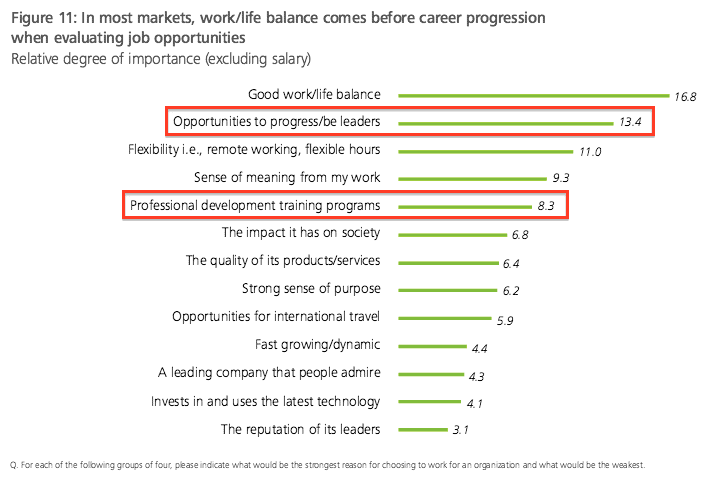
And a PwC study had similar findings, showing that 2 of the top 3 most attractive benefits for employers are related to growth and development:
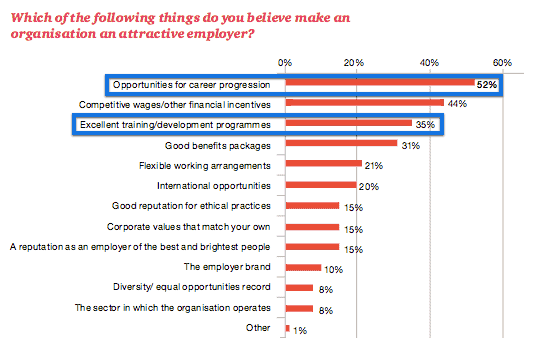
Finally, a CEB survey found that a lack of future career opportunities was the number one reason why people quit their job. It also showed that a stunning 70% of employees are dissatisfied with growth opportunities at their companies. [Ed note: Is it a coincidence that the percent satisfied with growth is about the same as Gallup's number for engaged employees?]
Everywhere we look, the data shows this is what employees want, yet they're not getting it. It's why they leave a job, and what they look for in their next role. If they're not growing at your company, they look for a new job where they can.
What to do about it: Make employee growth part of a manager's job.
The problem with growth and development today is that it almost never happens. The common pattern at most companies is there's a quick discussion at review time, and then it's not discussed again until next review.
That's discouraging and frustrating for your employees. It also creates a lot of uncertainty around promotions (Am I ready? What does it take?)
If a manager isn't going to have growth discussions with their team members, who will?
- A manager sees their team member's strengths and weaknesses better than anyone.
- A manager can more easily monitor progress.
- A manager should already have a structured time to talk about growth (their one on ones).
Without a clear plan, and regular discussions about it, it is too easy to let it slip. Unfortunately, that can prove costly as employees grow bored in current roles and seek new challenges at another company.

You need a plan.
As Linkedin's cofounder, Reid Hoffman, wrote in The Alliance, it's important for managers to sit down with their team members and lay out a path for growth. One on ones are a perfect time to do this, and ensure there's a time for follow up much sooner than the next review cycle.
Growth discussions and progress won't happen by accident. It must be prioritized by your company, and managers must be measured and rewarded for taking the time to do this.
Keep track of all your team members' growth plans in one place - download our free 1:1 meeting template now.

The good news is, it really does pay off. In Deloitte's Millennial study, they found that people with a mentor to help develop them were much more likely to stick around:
"Those intending to stay with their organization for more than five years are twice as likely to have a mentor (68 percent) than not (32 percent).”
A manager is the most obvious mentor for an employee. And even if the manager is not a fit, their help in finding a mentor inside or out of the company can be instrumental in ensuring growth happens. Even better, it will strengthen your employee-manager bond, as they'll appreciate you showing you care enough to help.
If you're looking for starting points for these growth discussions with your team, these links can help you:
- How to support team members to achieve goals.
- What to do if your team member doesn't know what their goals are.
- How to help employees grow and develop when you can't promote them.
- And don't forget about your own growth and that of any managers reporting to you by learning about the 8 best professional development goals for managers
3) Managers represent your company's leadership
CultureAmp came out with a report attempting to debunk the reality that employees quit because of managers not companies. What they found actually proved it.
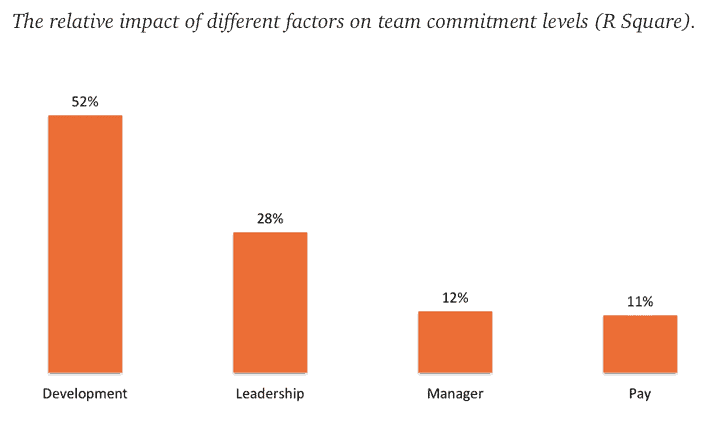
Their key finding was that the top contributors to engagement ("commitment levels") were actually related to company leadership, and career development opportunities.
As we just discussed, the manager plays an essential role in employee development. CultureAmp's analysis of their survey data just didn't directly associate it.
Their other major factor, leadership, is equally tied to the manager.
Leadership and managers are directly linked.
Outside of company all-hands meetings and occasional corporate-wide memos, a manager is an employee's strongest connection to company leadership day in and day out. Their communication (or lack thereof) is what keeps an employee feeling connected to the purpose of their work, and in the loop on what they need to know.
When communication breaks down somewhere in the leadership hierarchy, everyone suffers. This is when people feel out of the loop. It's also when they get frustrated by putting their efforts into work that doesn't matter.
It's the job of every manager to help with the flow of information up and down the organization. When people express frustration with leadership, like in the survey above, it's usually due to a failure in that flow.
Leaders also have a huge impact on the ranks below them. If a leader is disengaged or unhappy, the managers under them are likely to be as well. Gallup calls this the Cascade Effect:
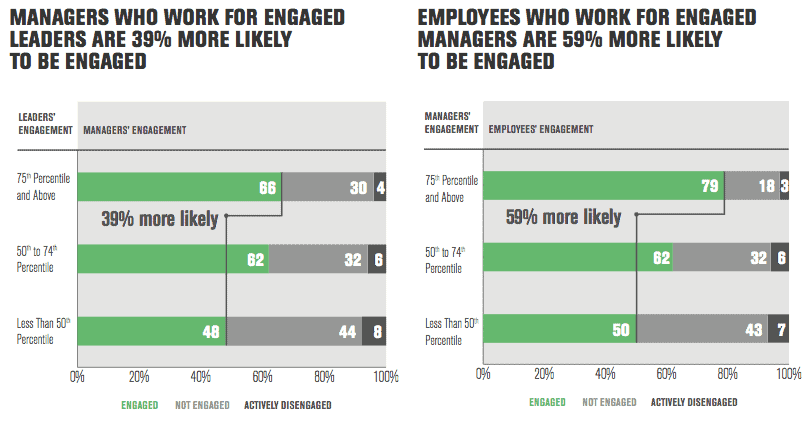
Managers have a huge impact on the commitment and happiness of their teams. The leaders above managers have the same impact on them. How leaders work to support, or undermine, their managers and teams will directly impact morale, and turnover.
What to do about it: Develop your communication architecture.
You must be intentional about developing your leaders, and adapting to maintain strong communication as your organization grows. Ben Horowitz tackles this issue in depth in his book, The Hard Thing About Hard Things, when he wrote:
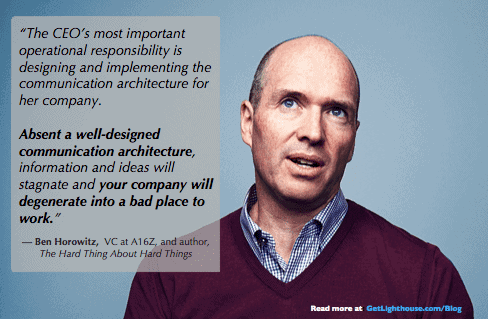
Building out your communication architecture means answering questions like:
- How do we inform everyone in the company about changes?
- How do we surface and raise insights to leadership from employees working on the front lines with customers?
- What habits do our managers have to support their teams beyond completing day to day tasks?
- How do we discover and address concerns employees have?
- What example are we setting for the managers below us?
One on ones are a huge part of a successful communication architecture, which is why Horowitz devoted an entire chapter to them in his book.
These meetings play a key role in more than just the happiness of front line employees. They also ensure that managers are supported by their superior (a common, major failing).
Without one on ones, a manager can be left to struggle, and under-perform, cascading down to everyone below them in the organization.
With them, information can freely flow up and down the organization, helping leaders with decision making. It also helps employees feel their opinions and insights are valued.
There are many ways to set your managers up for success. One of the most important is being intentional about how leaders set an example to be followed, and investing in supporting managers.
If you're looking for more ways to help your managers and a growing organization, start with these posts:
- Learn the benefits of and how to start skip level meetings
- Use your skip level 1 on 1s to improve your managers
- How to develop leaders in your organization
4) Never enough feedback and praise
If you do work, and no one notices, does it actually matter? For many in the workplace, they will go weeks without any feedback, good or bad. This can leave them feeling unappreciated, and questioning the value of their efforts.
Once again, the data supports this concern. In a study from Success Factors, they found that especially Millennials want more feedback than they're getting:
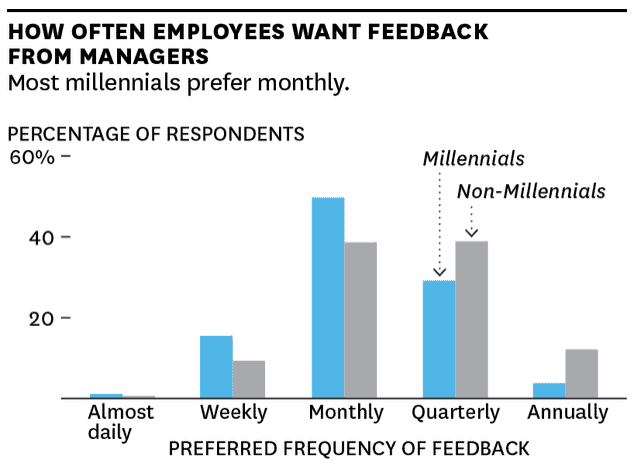
The good news we can see in this chart is that what employees are asking for is not extreme; almost no one is asking for daily or real time feedback. All your employees want is feedback on a semi-regular basis.
Giving praise matters.
No one wants to go the extra mile, if it goes unnoticed. Remember when you put in a big effort on a project, and then heard nothing from anyone about it? How did that make you feel?

As Mary Kay Ash, founder of the Mary Kay Cosmetics empire knows, praise has a big impact on how people feel about work. Think about how you felt the last time someone praised you for a job well done.
And it's more than a feeling. Research by Gallup found that praise (or a lack thereof) has a direct impact on turnover, and your bottom line:
- Getting "praise or recognition for good work” increases revenue and productivity 10% to 20%.
- Those feeling unrecognized are three times more likely to quit in the next year.
Harvard Business Review shared similar findings from other research where they found, "teams that are praised most outperformed those praised less across key criteria like financial performance, customer satisfaction, and 360-degree feedback."
Should this really be that surprising?
When people feel unappreciated, of course they leave. They'll go somewhere they're wanted.
They'll finally take up the offer from their friend that's been bugging them to join them for months, or their significant other, tired of hearing them complain about going unnoticed, will tell them to look for a new job.
What to do about it: Make feedback & praise a habit.
Waiting until review time to talk about career development misses out on a major opportunity to motivate your people. The same is true for feedback and praise. No one wants to get dumped dozens of things all at once, and then nothing for 6 months.
Instead, managers should work to build habits of giving praise regularly. If you see something you like, take a moment while you're thinking of it to share specifically why. There's a good chance that will lead to you seeing more of that desired action or result.
Meanwhile, best way to give feedback is to discuss it in private, and with proper context. This is once again where one on ones shine.
By using a structured, private time with your team member, you can realize a number of benefits:
- Gain context: By meeting in a one on one, you have time to hear their side of the story. This may change the nature of your feedback.
- Have plenty of time: One of the problems with "quick feedback" in the moment is you may be on your way to something else, preventing you from being 100% clear.
- Look for patterns: When you're reflecting before a on on one, identifying common patterns across work can make problems, and the necessary changes, more effective and clear than if you addressed each issue individually.
- Accountable: With regularly scheduled one on ones, it's clear when the next time you'll talk about an issue will be. It also gives you a time to remember to do it, despite your busy schedule.
- No fear: Since one on ones are a regularly scheduled event, you avoid the fear that can come with an unexpected meeting scheduled just to give feedback.
Your people are hungry to know how they're doing. As a manager, you're best positioned to provide that feedback.
You want to see your best people thrive, and your other people rise to acceptable levels. A healthy mix of feedback and praise can do that, all while helping prevent turnover.
Want to learn how to give feedback that makes a difference? Check out this episode of our "High Performing Teams" podcast or listen below.
5) People quit bosses due to an over-reliance on perks (but they don't work)
Perks are great for attracting people, but they have little effect on retaining them. No one ever stayed at a job because the free lunches, or competition on the ping pong table was too good. People leave managers not companies and their perks.
Researchers have been studying the impact of perks for decades. In Ferderick Herzberg's key research in the 1950s and 60s, he found that what motivates people is different than the hygiene factors that represent base needs and expectations of a workplace.
What this means for companies is that employees have some base expectations around salaries, benefits, and experience in the work place. If there are major problems with any of those things, it will cause them to become dissatisfied. However, improvements in them, will not significantly impact their motivation.
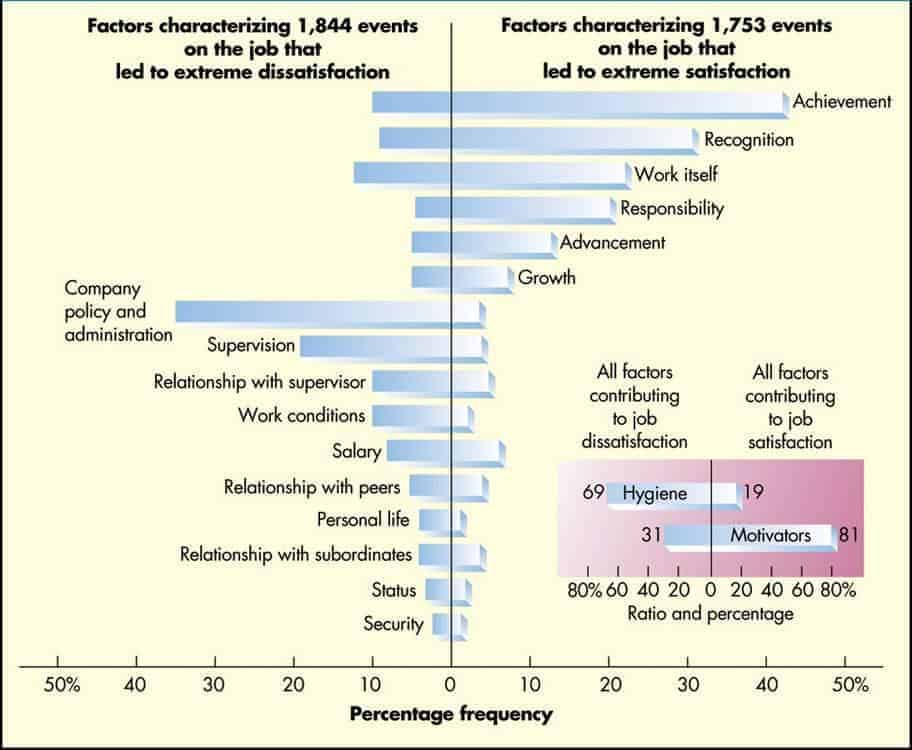
The chart above summarizes his findings, which show that Motivators have the greater impact; Motivators account for over 80% of job satisfaction, while also contributing to nearly 1/3rd of the causes of dissatisfaction.
Unfortunately, many companies have over-invested in hygiene factors. High pay, tons of perks, and over-investment in superficial aspects of "company culture" represent the wrong end of the 80-20 rule for impacting the motivation of your people.
The dark side of perks
Even more concerning, perks can create attitudes of entitlement. In Laszlo Bock's Work Rules, he shares how Google faced this repeatedly. They often experienced push back any time they changed, or removed a perk.
In one vivid example, they tried a "Meatless Monday" for their free company lunches and faced massive push back. Employees protested those cafeterias, and even brought grills to barbecue in the company parking lot.

One of the biggest problems with hygiene factors like perks is that their positive feelings are fleeting. We quickly get used to and expect them. This helps fuel an expensive arms race that leads to companies like Dropbox spending over $25,000 per employee on perks.
What to do about it: Focus on Motivators over more perks.
Perks can be expensive, but they're easy. Once you add a perk, it just continues to be a line item on your budget. There's little you have to think about.
Meanwhile, Motivators are inexpensive, but time-consuming. Training leaders to be great managers, and help their people grow does not happen by accident. It requires an ongoing commitment from many in your organization.
Returning to Herzberg's findings, you can see how large an impact Motivators and focusing on your manager can have on your people. Even some of the top hygiene factors are actually related to leadership (i.e.- Relationship with supervisor, Relationship with subordinates, and Supervision).
The next time you think about adding a perk, challenge yourself how beneficial it will really be for your company. Avoid the trap of choosing perks rather than the hard work of improving your managers.
Conclusion: Employees leave managers not companies, so it's on You to turn that around
If you are a manager, this should excite you. You have a tremendous amount of control over the morale, motivation, and retention of your team. As Andy Grove remarked above, you have control over the vast majority of the above challenges.
Regardless of what's happening around you, you can grow your people, give them feedback and praise, and improve your communication with them. Lighthouse can help you do this.
If you are a leader of an organization, a C-level executive, or in HR, this is a call to action for you. Investing in your managers is critical to your retention and engagement efforts. People leave managers not companies, and you have the power to do something about it at scale.
New managers need support from their managers. Leadership must prioritize the right habits being developed and practiced by every manager. HR must continue to invest in leadership and development, and help the layers in the org chart directly help one another.
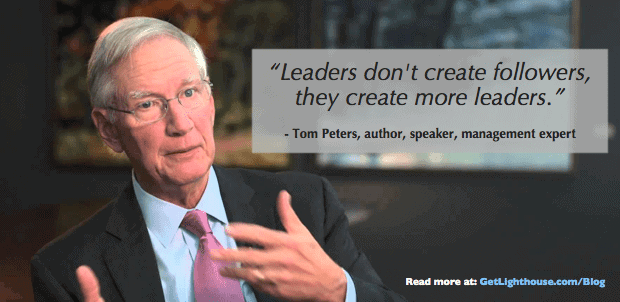
Great leadership cannot be outsourced. No company has ever had a great culture of leadership and management by accident. It's either a priority that's invested in with time and money to create more leaders, and people are measured against it, or it's not, and you'll see turnover higher than you'd like.
If you want to learn more about fighting turnover of all kinds, you can start here:
- 5 Reasons for High Employee Turnover (+ 5 Ways to Fix It)
- The Single Greatest Source of Your Organizational Problems (And Their Solutions)
- How to Reduce Nonprofit Employee Turnover without Breaking the Bank
- How to Calculate Employee Retention Rate
- How to Respond When an Employee Resigns

Why do employees leave managers not companies?
There are a number of reasons why employees leave managers not companies:
- Employees aren't getting the growth & development they want, so they seek it at another company. This shortens their tenure at each company they work at.
- A lack of communication creates a variety of issues that would be solved through strong 1 on 1 conversations.
- Employees also don't feel they get enough feedback and praise; they want to know how they're doing. It's their manager's job to provide much of this.
- Companies overly rely on perks and incentives (which don't work) for retention. No one stays at a job they're unhappy at because of the free lunches, or ping pong.
How do managers impact employee retention?
Managers have a significant impact on employee retention. Studies show that employees are more likely to leave an organization due to a poor relationship with their immediate supervisor rather than dissatisfaction with the company itself. A supportive and respectful manager can contribute to higher retention rates and reduce turnover costs.





